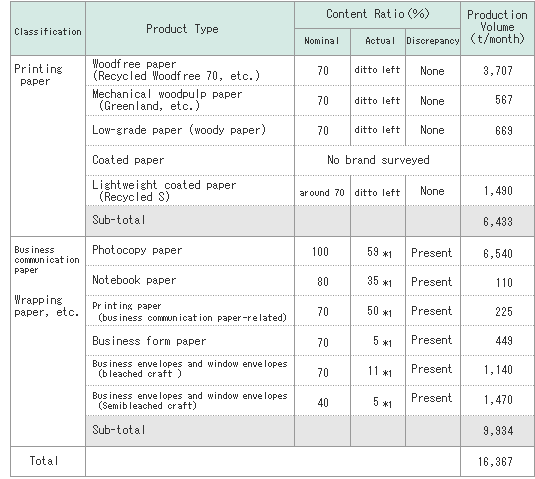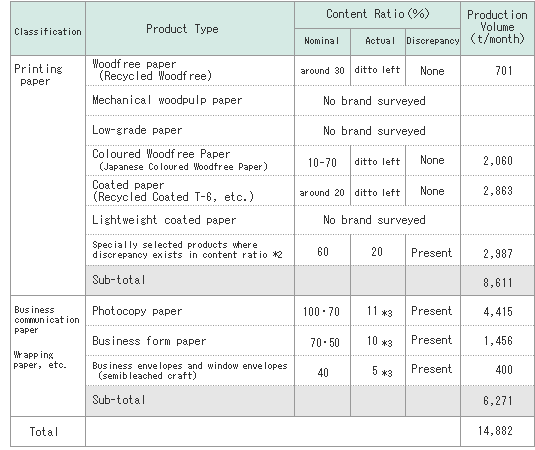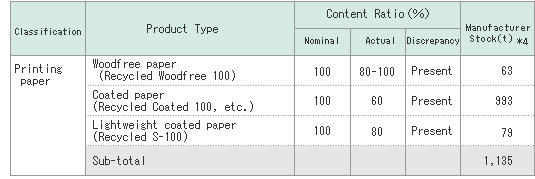January 16, 2008



Results of In-House Survey on Company's Products
Nippon Paper Industries Co., Ltd.
An in-house survey conducted on all of the Company's recycled paper products with respect to the de-inked pulp content ratio has revealed that products other than postcard (for New Year's greeting) grades also contained less than the agreed level. Details are shown on the attached paper, and products include those that do not meet the criteria of the Green Purchasing Law.
This situation has arisen from a technical difficulty in achieving the desired quality for those recycled paper products when increasing the de-inked pulp content ratio. Acknowledging the value of wastepaper as a key resource, until now the Company has put great effort into overcoming the technological challenges of maximizing the content of recycled fiber. However, the Company's current production technology would not satisfy the required product quality level without lowering the de-inked fiber content.
The Company takes seriously the fact that it has betrayed the public trust in an age when environmental issues are a matter of great public concern, and for this we offer our sincere apologies. In terms of our management responsibility, we take a grave view of this state of affairs. Once the total picture becomes clear, determining the cause and establishing where responsibility lay, we will make another statement.
As far as the Company's future initiatives are concerned, we will enlist the help of outside experts to enforce measures to prevent recurrence and redouble our efforts in respect of compliance. It goes without saying that we will take initiatives to develop our technology with a view to maximizing the utilization of wastepaper. At the same time, we will strive to achieve the optimum content, where de-inked fiber is efficiently and justifiably used depending on the desired whiteness and durability for every recycled grade.
Going forward, we will make renewed efforts to gain the understanding of our business partners, customers, and all other concerned parties in respect of company initiatives such as these.
Attached documentation: In-House Survey Report on Company's Products
(Attached documentation)
In-House Survey Report on Company's Products
This report details the results of the recent in-house survey, the facts ascertained, and the future initiatives of the Company, in the following order:
Description
Content of Report
1. Postcard (for New Year's greeting) grades
(1) Agreed specification for recycled fiber content
(2) Actual recycled (de-inked) pulp content
(3) Cause of discrepancy between the agreed specification and actual content
2. Products other than postcard grades
(1) Agreed specification and actual content ratio of de-inked pulp
(2) Cause of discrepancy between the agreed specification and actual content
3. Immediate actions and measures to prevent recurrence
1. Postcard (for New Year's greeting) grades
(1) Agreed specification for recycled fiber content
Chemical pulp: 60%
Recycled pulp: 40%
(2) Actual recycled (de-inked) pulp content
For 2008: 1%
From 1996 (when recycled grades were first adopted) to 2007: 1%-5%
(3) Cause of discrepancy between the agreed specification and actual content
Recycled grades began to be adopted for postcards in 1992, when we recognized that recycled fiber from the process wastes in our own mills could be regarded as "recycled pulp". After trial production using 30% process waste fiber and 6% de-inked pulp, we judged that it would be commercially viable to achieve the 40% content ratio of such recycled pulp, considering technological innovations in the near future, and began to accept commercial orders. However, the Company faced a problem when it became aware that process wastes were no longer classed as “recycled pulp.” The Company should have raised the content of de-inked pulp but could not help but maintain the same low content level for the sake of product quality, given the increased impurities such as dust and ink spots in post-consumer waste paper. Right up to the present, we have made every effort to operate in a way that would minimize the discrepancy, without success for the reason described above.
2. Products other than postcard grades
(1) Agreed specification and actual content ratio of de-inked pulp
As shown in the table attached, there find discrepancies between the specification and the actual content for such grades as PPC paper. With respect to the Products that are subject to the Green Purchasing Law, we will immediately suspend production of the Company's own brand products. As to the products (including the stock in store) for customers' OEM brand and specific business users (specially selected products) that failed in the agreed content of de-inked pulp, we will engage in urgent consultations with each client to settle this situation in a sincere manner.
(2) Cause of discrepancy between the agreed specification and the actual
1) Printing paper
The product contained de-inked pulp in accordance with the agreed specification when it first went on sale (around 1999). But as the quality of wastepaper fell, it was not always possible to keep the impurities in the product within the allowance. Despite the efforts we had made until then to improve our wastepaper treatment technology, cases arose where we could not support the product quality without failing to meet the de-inked pulp content criteria.
2) Business communication paper, wrapping paper, etc.
From around 1990, we were pushing forward with the use of recycled paper for photocopying grades to encourage recycling. At that time, we viewed the de-inked pulp content ratio as a challenge and we have been endeavoring to meet this challenge even after the Green Purchasing Law came into effect in 2001. Our understanding regarding the purpose of this law was inadequate.
At the same time, the quality level demanded from the outset was so high that it was not easy to increase the content of de-inked pulp. We continued to strive to increase the recycled fiber content but because of the diversity of output terminals consumers use today and the even higher quality level demanded for the paper products fed to them, along with the deteriorating quality of incoming waste paper, we were unable to increase the de-inked pulp content ratio. The same is true for the case of other recycled paper grades.
* The quality of business communication paper (PPC paper, business form paper) is evaluated by its printability (including its ability to run on the printing terminal without causing curling or jamming, and its dot and color reproducibility on all types of output terminal), dimensional stability subject to moisture absorption, level of contamination by dust and impurities, etc.
* The Green Purchasing Law does not stipulate the allowance for impurities and so forth.
3. Immediate actions and measures to prevent recurrence
The Company has issued instructions to suspend production and sale of the recycled products that do not meet the official specification. Further, we have also suspended accepting order placements for any of the said products. From now on, we will never manufacture any products that diverge from the established criteria.
In order to ensure that such a situation does not repeat itself, we are to set up an in-house fact-finding committee, which will make an exhaustive inquiry into the causes. Focusing on the items listed below, the committee will hold deliberations with our clients as well as with the authorities concerned and will investigate a policy to prevent recurrence.
(1) Compliance assurance
• Understanding of the Green Purchasing Law
• Schooling to raise environmental awareness
• Reconstruction of corporate compliance system
• Exhaustive compliance education
• Strengthened internal audits
(2) Regular quality review meetings with customers and users
(3) Monitoring system involving third-parties, such as customers and public organizations
Attached Table
1. Brands that the company is manufacturing as recycled paper (Production volume: October-December 2007)
(1) Products subject to Green Purchasing Law

*1 Content ratio is weighted average of brand and manufacturing plant
(2) Recycled paper other than that to which Green Purchasing Law applies

*2 Products for which de-inked pulp content is determined following negotiation with publisher or other user(content ratio is weighted average)
*3 Content ratio is weighted average of brand and manufacturing plant
2. Goods manufactured prior to September 2007 where discrepancy in content ratio existed which are currently in stock

*4 Products as at December 31, 2007
Agent stock (portion mentioned above in our company's warehouse) is approximately 3,600t, as mentioned above.